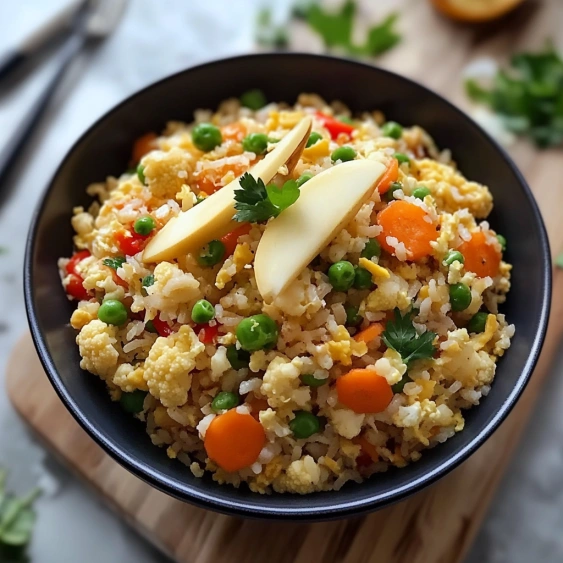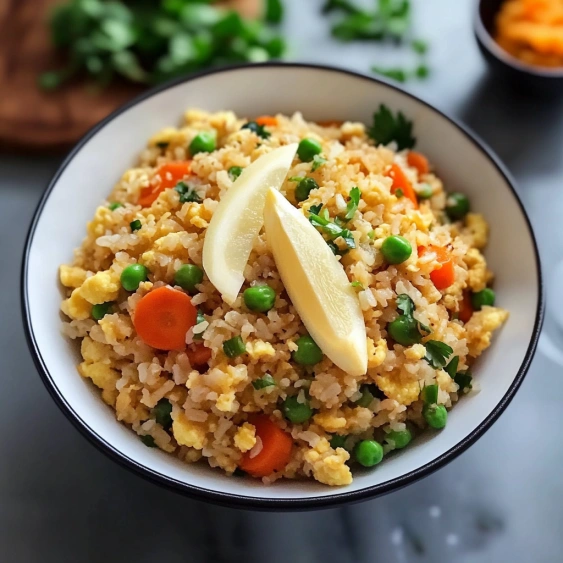 Pin it
Pin it
This cauliflower fried rice transforms a humble vegetable into a delicious low-carb alternative to traditional fried rice. Perfect for weeknight dinners, this dish delivers all the satisfaction of takeout with a fraction of the carbs and calories.
I first created this recipe when trying to cut back on carbs but was desperately craving Chinese takeout. Now it appears on our dinner table at least twice a month as a quick and satisfying meal that even my vegetable-skeptical spouse devours enthusiastically.
Ingredients
- Cauliflower head: Provides the perfect rice substitute texture with mild flavor that absorbs all the savory seasonings
- Olive oil: Helps crisp the cauliflower while adding healthy fats look for extra virgin for best flavor
- Mixed vegetables: Add color nutrition and texture frozen works perfectly fine here
- Eggs: Create richness and boost protein content use pasture raised for best flavor and nutrition
- Soy sauce: Delivers that classic umami flavor low sodium varieties work well too
- Green onions: Provide a fresh finish and subtle bite choose ones with firm stems and bright color
- Salt and pepper: Finish the dish perfectly use freshly ground pepper for best flavor
Step-by-Step Instructions
- Prepare the Cauliflower:
- Remove the outer leaves and cut into florets that will fit into your food processor. Pulse in batches until the cauliflower resembles rice grains. Don’t overprocess or it will become mushy. If you don’t have a food processor you can use the large holes on a box grater.
- Heat the Oil:
- Warm olive oil in a large skillet over medium heat until it shimmers but doesn’t smoke. Add the cauliflower rice and spread it evenly across the pan. Let it cook undisturbed for about 2 minutes before stirring to encourage some browning. Continue cooking for another 3 minutes stirring occasionally to prevent burning.
- Add Vegetables:
- Scatter your mixed vegetables evenly across the cauliflower. Keep stirring for 3 to 4 minutes until the vegetables brighten in color and soften slightly. Make sure to maintain medium heat to prevent scorching while allowing the vegetables to cook through.
- Add Eggs:
- Push everything to one side of the skillet creating an empty space. Pour the beaten eggs into this space and let them set slightly before scrambling with a spatula. Once the eggs are about 80 percent cooked fold them into the cauliflower mixture continuing to cook until eggs are fully set.
- Season:
- Drizzle soy sauce evenly across the mixture while continuing to stir. Sprinkle with green onions and add salt and pepper to taste. Cook for one more minute to allow flavors to meld. The cauliflower should be tender but not mushy with a slight bite similar to properly cooked rice.
 Pin it
Pin it
The cauliflower is truly the star of this dish. I discovered its versatility during a low carb diet phase and was amazed at how satisfying it could be. My favorite memory with this dish was serving it to my rice-loving father who took three bites before realizing he wasn’t eating actual rice. His surprised expression when I revealed the secret was absolutely priceless.
Make It Your Own
This recipe welcomes endless variations. Try adding diced chicken breast, bacon bits, or shrimp for extra protein. Vegetarians can toss in some firm tofu cubes or edamame. For heat lovers, a drizzle of sriracha or sambal oelek works wonders. You can also experiment with different seasoning blends like curry powder, five spice, or a dash of fish sauce for more complex flavors.
 Pin it
Pin it
Storage Tips
Cauliflower fried rice keeps beautifully in airtight containers in the refrigerator for up to 4 days. For meal prep I recommend slightly undercooking the vegetables so they don’t become mushy upon reheating. When reheating add a small splash of water to prevent drying out. While you can freeze portions for up to 2 months the texture may change slightly upon thawing so it’s best enjoyed fresh or refrigerated.
Perfect Pairings
Serve this cauliflower fried rice alongside teriyaki salmon, baked chicken thighs, or as part of an Asian-inspired feast. For a complete meal, consider adding a side of miso soup or a simple cucumber salad dressed with rice vinegar. This dish also works beautifully as a base for a grain bowl topped with a fried egg, avocado slices, and a drizzle of spicy mayo.
Frequently Asked Questions
- → How do I get the cauliflower rice texture right?
For perfect cauliflower rice texture, don't overprocess the cauliflower in the food processor - pulse it until it resembles rice grains but stop before it becomes mushy. Also, don't overcook it in the pan; 5-7 minutes is usually sufficient to make it tender while maintaining some bite.
- → Can I make this dish ahead of time?
Yes! Cauliflower fried rice keeps well in the refrigerator for 3-4 days in an airtight container. You can reheat it in a skillet or microwave until hot. The flavors often develop more when left overnight, making it a great meal prep option.
- → What protein can I add to make this a complete meal?
This dish works wonderfully with added protein. Try adding diced chicken, shrimp, tofu, or even leftover pork. Simply cook your protein first, set it aside, then add it back to the skillet when combining all ingredients at the end.
- → Can I use frozen riced cauliflower instead?
Absolutely! Frozen riced cauliflower works perfectly in this dish and saves preparation time. There's no need to thaw it first - just add it directly to the hot pan and cook until the excess moisture evaporates, which usually takes an extra 2-3 minutes.
- → How can I make this dish more flavorful?
To enhance flavor, try adding minced garlic and ginger when cooking the vegetables. A dash of sesame oil at the end adds wonderful aroma, while sriracha or chili paste can add heat. For umami depth, consider adding a tablespoon of oyster sauce or hoisin sauce along with the soy sauce.
- → Is cauliflower fried rice gluten-free?
This can easily be made gluten-free by substituting regular soy sauce with tamari or coconut aminos. Always check your other condiment labels to ensure they don't contain hidden gluten ingredients if preparing for someone with celiac disease or gluten sensitivity.
